
Wood is an incredibly versatile and widely used material that comes in a variety of shapes, sizes, and species. Understanding the different types of woods and their uses is essential for selecting the perfect wood for your project. In this article, we’ll take a closer look at the many different types of wood and their unique characteristics.
First, let’s consider Hardwoods, which come from deciduous trees. Hardwoods are known for their durability, strength, and beauty. Oak, one of the most popular types of hardwood, is commonly used for flooring and furniture due to its strength and attractive grain patterns. Maple is another hardwood that is well-suited for furniture making, thanks to its light color and subtle grain.
Next, let’s explore Softwoods, which come from coniferous trees. While not as strong as hardwoods, softwoods are often more affordable and easier to work with. Pine, for example, is a softwood that is commonly used for construction and building projects, such as framing and paneling.
Another type of wood to consider is Exotic Woods, such as teak and mahogany. These woods are known for their durability, resistance to insects and moisture, and rich colors. Teak, in particular, is a popular choice for outdoor furniture and boat building, thanks to its ability to withstand harsh weather conditions.
Finally, we can look at Engineered woods, such as plywood and MDF (medium-density fiberboard). These woods are made by combining several layers of wood, often with a synthetic adhesive, to create a more stable and durable material. Plywood, for example, is commonly used for flooring and sheathing, while MDF is often used for cabinetry and furniture.
Before we dive into the different types of wood and what they’re typically used for, it’s important to know that there are four main categories of wood: Hardwood, Softwood, Exotic woods, and engineered woods. Each of these types of wood can be used for different things.
- The Main Types of Wood
- Hardwoods
- Difference between Hardwoods and Softwoods
- Identifying Hardwood Trees
- Characteristics of Hardwood Trees
- Advantages of Using Hardwoods
- Durability and Strength
- Natural Beauty and Aesthetics
- Environmental Benefits
- Disadvantages of Using Hardwoods
- Cost and Availability
- The difficulty of Working with Hardwoods
- Sustainability Concerns
- Softwoods
- Properties of Softwood
- Advantages of Softwood
- Engineered Wood
- History of Engineered Wood
- Types of Engineered Wood
- Construction
- Furniture Making
- Decorative Items
- Exotic Woods
- Types of Woods for Woodworking, Furniture, etc.
- Ash
- Balsa
- Bamboo
- Basswood
- Beechwood
- Birch
- Butternut
- California Redwood
- Catalpa
- Cedar
- Cherry
- Chestnut
- Cork
- Douglas
- Ebony
- Fir
- Gaboon
- Hemlock
- Hickory
- Iroko
- Koa
- Lacewood
- Lignum Vitae
- LVL
- Lyptus
- Mahogany
- Maple
- MDF
- Oak
- Olivewood
- OSB
- Osage Orange
- Padauk
- Plywood
- Pine
- Purpleheart
- Redwood
- Rosewood
- Sapele
- Sequoia
- Spruce
- Sycamore
- Teak
- Tulipwood
- Walnut
- Whitewood
- Zebrawood
The Main Types of Wood
| Type of Wood | Characteristics | Common Uses |
|---|---|---|
| Softwood | Comes from conifer trees | Often less dense and less expensive than hardwood, used in construction, furniture, and paper products |
| Hardwood | Comes from deciduous trees | Often more durable and dense than softwood, used in furniture, flooring, and cabinetry |
| Engineered Wood | Made up of various wood products | More stable and stronger than solid wood, used in construction, furniture, and cabinetry |
And here is a table that includes exotic wood as well:
| Type of Wood | Characteristics | Common Uses |
|---|---|---|
| Softwood | Comes from conifer trees | Often less dense and less expensive than hardwood, used in construction, furniture, and paper products |
| Hardwood | Comes from deciduous trees | Often more durable and dense than softwood, used in furniture, flooring, and cabinetry |
| Engineered Wood | Made up of various wood products | More stable and stronger than solid wood, used in construction, furniture, and cabinetry |
| Exotic Wood | Imported from tropical regions | Known for unique and distinctive characteristics, used in high-end furniture and musical instruments |
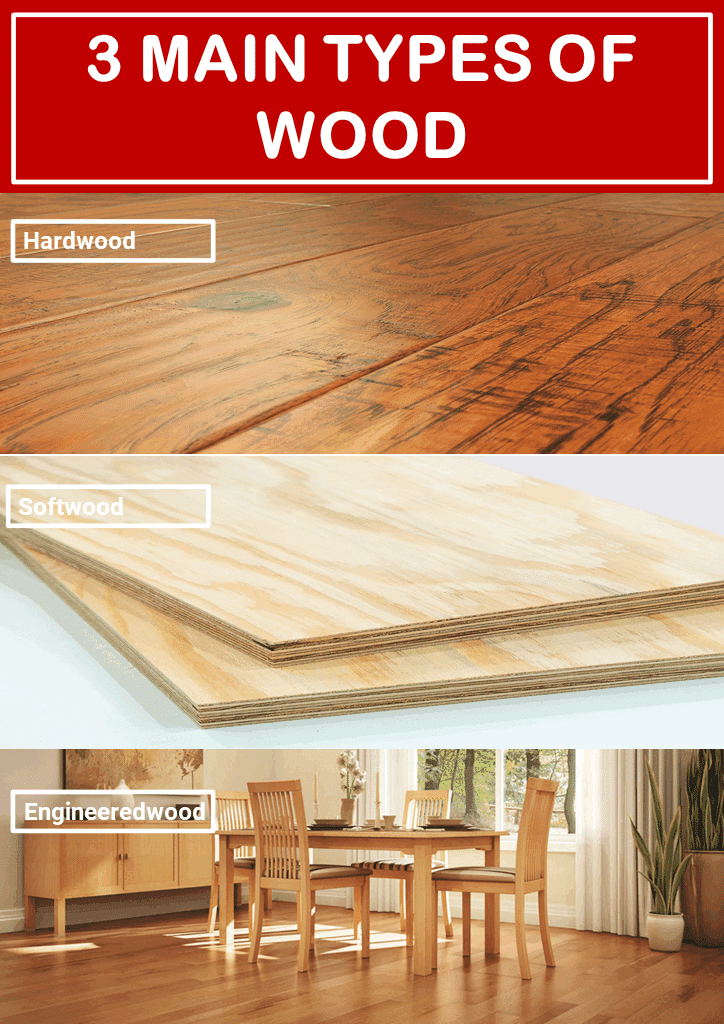
Wood is a versatile material that can be used in a variety of ways. There are three main types of wood: softwoods, hardwoods, and engineered wood. Each of these wood types has unique characteristics that make them suitable for different applications.
Hardwoods
Hardwoods are a type of tree that is known for their dense and durable wood. They are not necessarily harder than softwoods, but they are denser and more durable. Hardwood trees are deciduous (a type of tree that loses its leaves every autumn), which means they shed their leaves annually. They grow more slowly than softwoods and are more expensive to harvest and process.
Difference between Hardwoods and Softwoods
The terms hardwood and softwood can be misleading. Hardwoods are not necessarily harder than softwoods. The term hardwood refers to trees that are deciduous, meaning they shed their leaves annually. Softwoods, on the other hand, are evergreen trees that have needles or scale-like leaves. Softwoods are also known as conifers.
Conifers: a tree with short, very thin leaves (needles) that stay green all through the year and that has hard brown fruit (cones)
Identifying Hardwood Trees
Identifying hardwood trees can be challenging because there are many different species, and they can look very similar. However, there are some common characteristics that can help you identify a hardwood tree.
Some common hardwood species and their identifying features include:
- Oak: Oak trees have a distinctive leaf shape, with lobes and sinuses that vary depending on the species. They have a rough, fissured bark and produce acorns.
- Maple: Maple trees have distinctive leaves with three to five lobes, and their bark is gray and smooth when young, becoming rougher with age. Some maple species produce sap that can be harvested to make maple syrup.
- Cherry: Cherry trees have a smooth, shiny bark that is reddish-brown. They produce small, red fruits called cherries.
- Walnut: Walnut trees have compound leaves with 13 to 23 leaflets, and their bark is grayish-brown and deeply furrowed. They produce edible nuts.
Characteristics of Hardwood Trees
Hardwood trees have a number of identifying features, including their leaves, bark, and growth habits. Hardwood leaves are usually broad and flat, and they often change color in the fall. Hardwood bark is often rough and deeply furrowed. Hardwoods also tend to grow more slowly than softwoods and have dense, heavy wood.
Advantages of Using Hardwoods
There are many advantages to using hardwoods in construction, furniture making, and other applications. Some of the advantages of using hardwoods include:
Durability and Strength
Hardwoods are known for their strength and durability, which makes them ideal for use in high-traffic areas and in structures that need to withstand heavy loads. Hardwoods also resist wear and tear and are less prone to damage from moisture and pests.
Natural Beauty and Aesthetics
Hardwoods have a natural beauty and warmth that cannot be replicated by synthetic materials. They come in a wide range of colors, grains, and textures, and can be used to create unique and visually stunning designs.
Environmental Benefits
Using hardwoods can also have environmental benefits. Trees are a renewable resource, and many hardwood species are grown sustainably. When harvested responsibly, hardwoods can provide a sustainable source of wood for construction, furniture making, and other applications.
Disadvantages of Using Hardwoods
While there are many advantages to using hardwoods, there are also some disadvantages to consider. Some of the disadvantages of using hardwoods include:
Cost and Availability
Hardwoods can be expensive, especially if they are rare or difficult to harvest. Additionally, not all hardwoods are available in all regions, which can limit their availability for certain applications.
The difficulty of Working with Hardwoods
Hardwoods are denser and more difficult to work with than softwoods, which can make them more challenging to use in some applications. They may require specialized tools and techniques to work effectively.
Sustainability Concerns
Some hardwood species are not grown sustainably, which can lead to deforestation and other environmental problems. It is important to choose hardwoods that are grown sustainably and harvested responsibly.
Softwoods
Softwood is a type of wood that comes from coniferous trees, which are trees that have needles instead of leaves. Coniferous trees are usually evergreen, which means that they keep their needles all year round. Softwood is commonly used in construction, furniture making, and woodworking.
Softwoods Like Pine, Spruce, Cedar, Fir, and Redwood are Used.
Properties of Softwood
Softwood has several properties that make it suitable for various applications. Some of the properties of softwood include:
- Lightweight
- Easy to work with
- Resistant to warping and twisting
- Strong and durable
- Naturally resistant to decay and insects
Advantages of Softwood
There are several advantages of using softwood, including:
- Affordability: Softwood is generally more affordable than hardwood.
- Availability: Softwood is widely available and can be easily sourced.
- Versatility: Softwood can be used for various applications, such as construction, furniture making, and woodworking.
Softwood is commonly used for framing, roofing, and decking in construction.
Furniture making: Softwood is used for making furniture, such as chairs, tables, and cabinets.
Woodworking: Softwood is used for various woodworking projects, such as carving and turning.
Engineered Wood
Engineered wood, also known as composite wood, is a type of wood product that is created by bonding together wood veneers, fibers, or particles using adhesives. This process results in a stable and strong product that can be used in various applications. Unlike solid wood, engineered wood is made from various wood materials that are glued together, which gives it its unique properties.
History of Engineered Wood
The use of engineered wood can be traced back to the early 20th century. The invention of plywood by Immanuel Nobel, the father of Alfred Nobel, in 1867 laid the foundation for the development of engineered wood. Later on, in the 1960s, the use of engineered wood became more prevalent in the construction industry, and today, it has become a popular alternative to traditional wood.
Reference: Wikipedia
Types of Engineered Wood
There are different types of engineered wood, and each has its unique characteristics and properties. Here are some of the most common types of engineered wood:
- Plywood:
- MDF:
- OSB:
- LVL:
Construction
Engineered wood products are commonly used in construction, such as for framing, flooring, and roofing. They are especially useful in situations where strength, stability, and cost-effectiveness are important factors.
Furniture Making
Engineered wood products can be used to create furniture, such as cabinets, tables, and chairs. They are often used in combination with traditional solid wood products to create a unique and durable piece.
Decorative Items
Engineered wood products can be used to create decorative items, such as wall panels and molding. They offer a cost-effective and sustainable alternative to traditional solid wood products.
While there are many advantages to using engineered wood products, there are also some potential disadvantages to consider. For example, some types of engineered wood products may contain harmful chemicals, such as formaldehyde. It is important to carefully research and select engineered wood products that are safe and eco-friendly.
Exotic Woods
Apart from hardwoods and softwoods, there are also exotic woods, which come from trees that are not native to North America. These woods are often prized for their unique colors, grain patterns, and other characteristics.
Types of Woods for Woodworking, Furniture, etc.
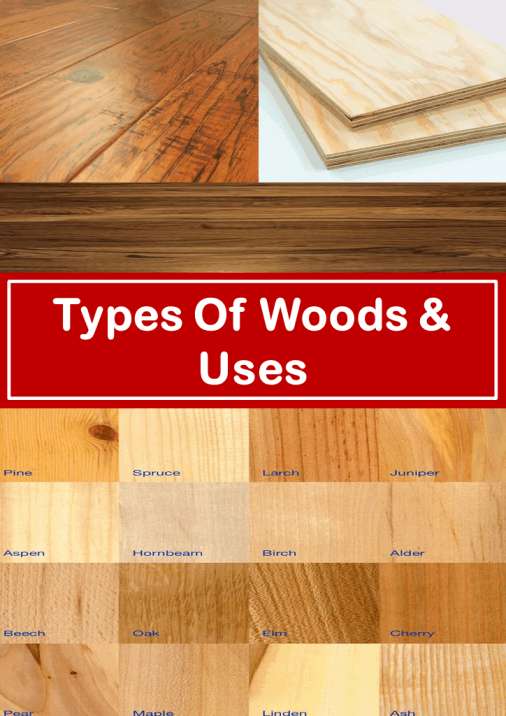
Although there are three primary categories of wood, there exists an extensive array of wood varieties and species, amounting to thousands in number. The succeeding section aims to discuss the frequently encountered woods in the domains of woodworking and construction.
Each wood variety will be presented with an outline of its general features and a description of its optimal utilization. The woods are arranged in alphabetical order, ensuring effortless navigation through the list in case you are looking for a specific type of wood.
Ash
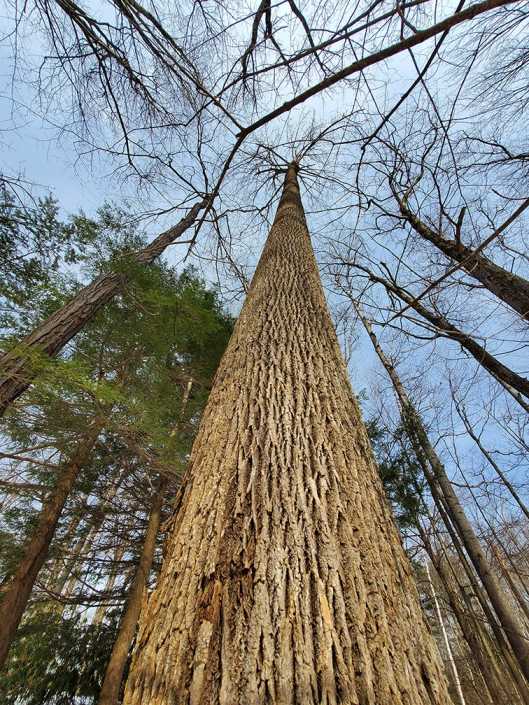
Ash has a rich history that dates back to ancient times. The wood of the Ash tree has been used for various purposes, including making weapons, furniture, and sports equipment. The ancient Greeks believed that the Ash tree had magical powers and used it to make spears, bows, and arrows. The wood of the Ash tree was also used in the construction of the famous Viking longboats.
Ash is a large tree that can grow up to 30 meters in height. The bark of the Ash tree is smooth and gray, and it has a distinct diamond-shaped pattern. The leaves of the Ash tree are compound, meaning that they are made up of several leaflets. The leaflets are bright green and oval-shaped, and they turn yellow in the fall.
Balsa
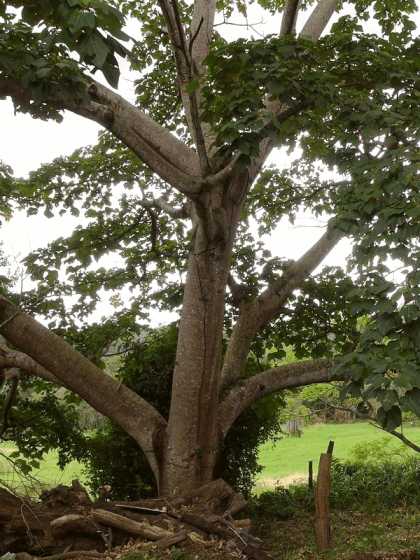
Balsa is a lightweight, fast-growing hardwood that is native to Central and South America. It is a member of the Malvaceae family, which includes cotton and hibiscus. The tree can grow up to 30 meters tall and its trunk can reach up to 1 meter in diameter. Balsa wood has been used for a variety of purposes throughout history.
The use of balsa wood can be traced back to the ancient Incas, who used it for making rafts, paddles, and other small boats. The wood was also used for making masks, statues, and other decorative objects. The Incas were able to cultivate balsa trees by using a technique called “tequila,” which involves cutting down trees and replanting them in a way that encourages growth.
In modern times, balsa wood is primarily used for its lightweight and buoyant qualities. It is commonly used in the construction of model airplanes, boats, and other small-scale structures. Balsa wood is also used in the production of surfboards, where its light weight and buoyant properties make it an ideal material for shaping and carving.
Bamboo

Bamboo is a woody grass with a long history of use by humans, particularly in East and Southeast Asia.
It has been used for construction, furniture, paper, musical instruments, and even as a food source. The fast-growing nature and versatility of bamboo make it a sustainable alternative to traditional wood products.
It is also increasingly used in modern architecture and design due to its strength, flexibility, and aesthetic appeal. Bamboo is now being recognized as a valuable resource in the quest for more sustainable and environmentally friendly materials.
Basswood
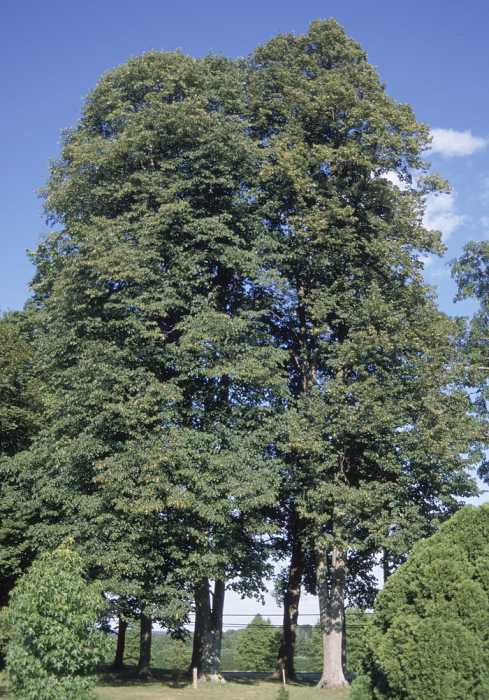
Basswood is a popular wood species that has been used for centuries for a variety of purposes. It is a light, soft, and flexible wood that is easy to carve and work with.
Basswood has a long history of use in traditional crafts, such as carving, sculpture, and basket weaving. It has also been used in the construction of musical instruments, such as guitars, violins, and drums.
In addition, basswood is commonly used for making furniture, cabinets, and decorative trim. Its light color and fine, even texture makes it a versatile wood that can be stained or painted to match any decor.
Beechwood

Beech is a hardwood species native to Europe, Asia, and North America. Historically, beech wood has been used for a wide range of purposes, from furniture-making and carpentry to flooring and even fuel. In ancient times, beech wood was often used to make tools, such as axes and mallets, due to its strength and durability.
In medieval Europe, beech was a popular choice for constructing church pews and other furniture due to its beautiful grain patterns and resistance to decay. During the Renaissance, beech became even more popular as a material for furniture, and it was used extensively in the production of chairs, tables, and cabinets.
Birch
Birch is a type of hardwood tree that is native to the northern hemisphere, including regions of Europe, Asia, and North America. Historically, birch has been used for a variety of purposes due to its strength, flexibility, and beautiful appearance.
One of the earliest uses of birch was by indigenous peoples, who used the bark to create canoes, containers, and baskets. The bark was also used for medicinal purposes, as it contains compounds that have anti-inflammatory and pain-relieving properties.
In Europe, birch has been used for centuries to make furniture, flooring, and other household items. The wood is prized for its light color and fine grain, and it is also easy to carve and work with. Birch plywood, which is made by laminating thin sheets of birch together, is commonly used in construction and manufacturing due to its strength and durability.
Butternut
Butternut, also known as white walnut, is a hardwood species native to North America. Its wood has been used for centuries for a variety of purposes, including furniture, cabinetry, and carving.
The history of butternut wood dates back to the early days of American colonization, when it was a favored material for furniture makers due to its attractive grain patterns and ease of working. During the 18th and 19th centuries, butternut wood was also widely used in the construction of barns and homes.
Today, butternut wood remains a popular choice for furniture and cabinetry makers, as well as for carving and woodworking enthusiasts. Its warm, golden-brown color and distinct grain patterns make it a sought-after material for creating decorative pieces and artistic carvings.
California Redwood
California Redwood is a species of tree that can be found along the west coast of North America.
The tree species has a long history of use by Indigenous peoples, who used it for various purposes including building materials, tools, and medicine.
The wood is known for its durability, resistance to insects, and attractive appearance, making it a popular choice for outdoor furniture and decking.
Today, the California Redwood is heavily managed and regulated to ensure its sustainability for future generations.
Catalpa
Catalpa is a type of tree that is native to North America. It has been used for various purposes throughout history, including in shipbuilding, furniture making, and as a medicinal plant. The wood of the Catalpa tree is known for its durability, resistance to rot, and lightweight, making it a popular choice for building canoes, boats, and other watercraft.
The tree’s leaves and bark have also been used in traditional medicine to treat a variety of ailments, including fever, coughs, and skin conditions. Today, Catalpa is primarily grown for its ornamental value and is often used in landscaping and as a shade tree.
Cedar
Cedarwood has a rich history and has been used for various purposes for thousands of years. The wood has been found in ancient Egyptian tombs and was used by Native American tribes for building longhouses and canoes. Cedar wood is known for its natural resistance to rot, insects, and decay, making it a popular choice for outdoor furniture, decking, and siding.
It is also used for making chests and closets due to its ability to repel moths and other insects. In addition to its practical uses, cedar wood is prized for its pleasant aroma and is often used in aromatherapy and as an ingredient in soaps and perfumes.
Cherry
Cherrywood is a popular hardwood that has been used for centuries for various purposes. It has a rich history and was highly prized by ancient civilizations for its durability, strength, and beauty. Cherry wood was used by the Egyptians for making furniture, while the Greeks and Romans utilized it for shipbuilding and architecture.
In modern times, cherry wood is still highly valued for its rich reddish-brown color and unique grain patterns. It is commonly used for furniture making, cabinetry, flooring, and decorative items. Cherry wood is also a popular choice for musical instruments such as guitars, violins, and pianos due to its superior tonal qualities.
The use of cherry wood is not limited to practical applications. It is also a favorite of woodworkers and artisans due to its natural beauty, warmth, and depth of color. From ancient times to modern times, cherry wood remains a highly desirable and versatile material that continues to be cherished and admired by many.
Chestnut
Chestnut wood has been used for centuries in Europe and Asia for construction, furniture, and fuel. In North America, chestnut trees were devastated by a blight in the early 1900s, greatly reducing the availability of wood. Today, chestnut wood is valued for its durability, beauty, and sustainability, and is used for flooring, cabinetry, and decorative woodwork.
Cork
Wood has been used by humans for thousands of years, initially for fuel and tools, then for shelter and transportation. Today, wood is used for a variety of purposes, including construction, furniture, paper, and energy production. Cork, a type of wood harvested from the cork oak tree, is commonly used for wine bottle stoppers, flooring, and insulation.
Douglas
Douglas fir is a coniferous tree species native to North America. It has a long history of use in construction, furniture making, and paper production due to its strength and durability. It is also a popular choice for Christmas trees. Douglas fir forests have faced environmental threats such as logging and wildfires.
Ebony
Ebony is a dense, black hardwood found in tropical regions. It has been prized for its beauty and durability for centuries and was used extensively in ancient Egyptian and Roman furniture. Today, it is used for musical instruments, decorative objects, and high-end furniture due to its striking color and hardness.
Fir
Fir is a coniferous tree species that has been used for centuries for various purposes such as construction, paper production, and fuel. Its use in construction dates back to ancient times, and it remains a popular choice for lumber due to its strength, durability, and natural resistance to decay. Additionally, its attractive appearance has made it a popular choice for Christmas trees and decorative items.
Gaboon
Gaboon is a country located in Central Africa, known for its dense forests and rich biodiversity. The history of wood in Gaboon dates back to ancient times when local communities used it for various purposes, including construction, tool making, and fuel.
Today, Gaboon is a major exporter of tropical hardwoods, such as Okoume, ebony, and mahogany, which are highly valued for their durability and aesthetic appeal. Wood from Gaboon is used in a variety of industries, including furniture, flooring, and boat building, and is sought after by artisans and manufacturers worldwide.
Hemlock
Hemlock is a type of coniferous tree that has been used for various purposes throughout history. Native Americans used its bark for medicinal purposes, while European settlers used it for shipbuilding and construction.
Hemlock wood is known for its durability and resistance to decay, making it popular for outdoor projects like fencing and decking. It’s also used in furniture and flooring due to its attractive grain patterns. Today, hemlock is a widely available and sustainable resource that continues to be used in many different applications.
Hickory
Hickory is a type of hardwood tree native to North America, known for its strength and durability. Its wood has been used throughout history for a variety of purposes, including tool handles, furniture, flooring, and even sports equipment.
Hickory was highly valued by Native Americans who used it to make bows and arrows, and later by European settlers who recognized its strength for building homes and wagons.
Today, hickory is still widely used for furniture and flooring, as well as for smoking meats and adding flavor to foods. Its rich, distinctive grain pattern and warm, reddish-brown color make it a popular choice for rustic and traditional-style interiors.
Iroko
Iroko is a hardwood tree that is native to tropical regions of Africa. The wood of the Iroko tree has been used for various purposes throughout history, such as for construction, boat building, furniture, and flooring.
In African cultures, Iroko wood is often associated with spiritual and medicinal properties and has been used for carving traditional masks and statues. Today, Iroko wood is still prized for its durability, resistance to rot, and beautiful grain patterns, and is commonly used for outdoor decking, cladding, and other exterior applications.
Koa
Koa is a species of tree native to Hawaii, known for its beautiful wood grain and rich history. Koa was traditionally used by Hawaiians to create canoes, surfboards, and weapons, and was considered a sacred wood by many.
In modern times, Koa is often used for furniture, musical instruments, and decorative items. The wood is prized for its warm color, unique figure, and durability.
However, due to over-harvesting and habitat loss, Koa is now considered a rare and valuable resource, and efforts are being made to protect and restore Koa forests.
Lacewood
Wood has been used by humans for various purposes since ancient times. From building shelters to crafting furniture, wood has been an integral part of our lives. Lacewood, also known as leopardwood, is a type of wood that has been historically used for decorative purposes due to its unique and striking grain patterns.
It is commonly used in cabinetry, musical instruments, and veneers. The wood is moderately heavy and has good strength, making it suitable for structural purposes as well.
With its distinctive appearance and versatility, lacewood continues to be a popular choice among woodworkers and designers.
Lignum Vitae
Lignum Vitae, also known as Guaiacum officinale, is a dense and durable wood native to the Caribbean and Central and South America. It has a rich history of use in shipbuilding, where it was used for propeller shafts, bearings, and other parts that required high strength and resistance to wear and corrosion.
Lignum Vitae has also been used in traditional medicine for its purported healing properties, as well as in musical instruments and decorative carvings. Due to its scarcity and high demand, Lignum Vitae is now a protected species, and its harvest is strictly regulated.
LVL
Wood has been used as a building material for thousands of years, with evidence of wooden structures dating back to ancient times.
Throughout history, wood has been used for everything from simple homes and furniture to elaborate temples and palaces. In modern times, wood remains an important material for construction, furniture, and decorative purposes.
Laminated Veneer Lumber (LVL) is a type of engineered wood made from thin layers of wood veneer glued together. It is known for its strength, stability, and versatility, making it a popular choice for structural applications in the construction industry.
Lyptus
Lyptus is a type of wood that originated in Brazil and was first introduced in the market in the late 1990s.
It is a hybrid of two species of eucalyptus, which makes it an environmentally friendly option. Lyptus has become popular for furniture making, flooring, and cabinetry due to its durability, hardness, and attractive grain patterns.
It is also used in the production of pulp and paper. The wood has a warm reddish-brown color and can be finished with a high polish. Its history is relatively short, but its popularity has grown rapidly due to its versatility and sustainability.
Mahogany
Mahogany is a hardwood that has been used for centuries in furniture-making, boat-building, and other applications. It is native to Central and South America and was first discovered by European explorers in the 16th century.
The wood is prized for its rich reddish-brown color, durability, and resistance to decay and insects.
Mahogany has been used to create some of the world’s most beautiful and iconic pieces of furniture, including tables, chairs, and cabinets.
Today, sustainable forestry practices are helping to ensure that mahogany remains available for future generations to enjoy.
Maple
Maple is a type of hardwood tree that has been used for various purposes throughout history. The wood of the Maple tree has been used for centuries in furniture making, flooring, cabinetry, and musical instruments.
The Native Americans used Maple sap to make syrup and sugar, while early settlers used wood to construct homes and buildings.
Today, Maple is still widely used in woodworking due to its durability, strength, and beautiful natural grain patterns. It is also a popular choice for cutting boards, kitchen utensils, and decorative items.
MDF
Wood has been used for thousands of years in human history for various purposes such as construction, furniture making, and as a source of fuel. However, as technology has advanced, new types of wood-based products have been developed, such as Medium-density fibreboard (MDF).
MDF is a composite material made from wood fibers, resin, and wax, which is widely used in the furniture industry due to its affordability, durability, and consistency. It is also used in construction for paneling, flooring, and other applications.
Despite being a man-made product, MDF has become a popular alternative to solid wood due to its versatility and ease of use.
Oak
Oak is a hardwood species that has been valued by humans for centuries due to its strength and durability. It has a rich history of use in shipbuilding, furniture-making, and construction.
Oak has been a symbol of strength and longevity, often used in the construction of cathedrals and other important buildings.
It has also been used for barrels to store wine and spirits, as well as for firewood and charcoal production (Briquettes). Today, oak is still widely used in furniture-making, flooring, and decorative woodwork due to its unique and beautiful grain pattern.
Olivewood
Wood has been used by humans for thousands of years, dating back to prehistoric times. It has been used for construction, furniture, tools, and many other purposes. Olivewood, in particular, has a rich history and is known for its beautiful grain patterns and durability.
It has been used for centuries to make religious artifacts, as well as for carving and decorative purposes.
Today, olivewood is still popular for its unique appearance and is often used for kitchen utensils, cutting boards, and other household items. It is also a popular choice for woodworkers and artisans due to its natural beauty and strength.
OSB
Wood has been used for various purposes throughout human history, from fuel to construction material.
It has been an essential resource for building structures, furniture, and other objects. Oriented strand board (OSB) is a type of wood composite made by compressing wood strands with adhesive. It has become a popular construction material due to its strength, durability, and affordability.
OSB is commonly used for flooring, roofing, and wall sheathing in residential and commercial buildings. Its versatility, low cost, and ease of installation have made it a preferred alternative to plywood in many applications.
Osage Orange
Osage Orange is a species of tree that is native to North America. It has a long history of use by indigenous peoples, who used the wood for making bows, and as a source of dye.
During the 19th century, the tree became popular for use as a hedge due to its dense, thorny branches. It was widely planted across the United States as a living fence, especially in the Midwest.
Today, Osage Orange is still used for making archery bows, as well as for furniture, flooring, and fence posts.
Padauk
Padauk is a type of hardwood that is native to tropical regions of Africa and Asia. It has been used for centuries in furniture making, cabinetry, and decorative carving due to its durability and rich, reddish-orange color.
Padauk was also used in traditional African and Asian medicine for its anti-inflammatory properties.
In recent years, Padauk has gained popularity in musical instrument-making due to its tonal qualities. Despite its many uses, Padauk has now considered an endangered species due to deforestation and over-harvesting.
Plywood
Plywood is a versatile and popular material made from thin layers or “plies” of wood veneer that are glued together. It has been used for centuries in various applications, including furniture, construction, and decorative paneling.
The ancient Egyptians and Greeks used it for furniture and decorative purposes. In the 20th century, plywood became a popular material for home construction due to its strength, durability, and versatility.
Today, plywood is used in a wide range of industries, including aerospace, automotive, and packaging. It is also popular in DIY projects and furniture making.
Pine
Pine is a coniferous tree species that has been used for centuries in various cultures for its wood. In the United States, Native Americans used pine needles to make baskets and pine bark to cover their homes.
Pinewood has been used for furniture, flooring, and construction because of its strength, durability, and attractive grain patterns.
In addition, pine tar has been used for its medicinal properties to treat skin conditions and pine essential oil is used in aromatherapy for its calming and soothing effects. Pinewood has also been used in the paper and pulp industries.
Purpleheart
Purpleheart is a hardwood species native to Central and South America, known for its distinctive purple color. Wood was traditionally used by the indigenous peoples of the region for making tool handles, bows, and other items. During the colonial era, Purpleheart was exported to Europe for use in fine furniture, flooring, and other decorative applications.
Today, it is popular for use in high-end woodworking projects, such as musical instruments and turnery, due to its durability and striking coloration. Despite its popularity, over-harvesting has led to concerns about the sustainability of Purpleheart supplies in some areas.
Redwood
Redwood is a type of tree species that is native to the west coast of North America, particularly California.
The tree is known for its reddish-brown bark and is considered one of the tallest and largest tree species in the world.
Redwood has been used for a variety of purposes throughout history, including as building materials for homes, furniture, and boats.
It is also commonly used in landscaping and as a source of lumber for the construction industry. Due to its durability and strength, Redwood remains a popular choice for construction and design projects today.
Rosewood
Wood has been an essential material for human civilization since ancient times. It has been used for construction, furniture, tools, and art. Rosewood, a dark-colored hardwood, has a long and rich history of use in high-end furniture, musical instruments, and decorative items.
Its distinct color and grain pattern make it highly sought after, but its popularity has also led to overharvesting and illegal trade. Today, rosewood is protected by international laws and regulations, and sustainable sourcing practices are being developed to preserve this valuable resource for future generations.
Sapele
Sapele is a type of wood that originates from West Africa and has been used for centuries in a variety of applications. Historically, it was a popular choice for shipbuilding, as well as for the production of furniture and musical instruments due to its durability and attractive reddish-brown color.
Today, Sapele wood is still commonly used for furniture, flooring, and cabinetry, as well as for decorative veneers. It is also prized by woodworkers for its stability and ease of working with, making it a popular choice for a variety of projects.
Sequoia
Sequoias are a type of giant redwood tree native to California. Historically, Sequoia wood was highly valued for its durability and strength and was used extensively in the construction of buildings, ships, and railroad ties.
Native Americans also used Sequoia bark for baskets and other crafts. Today, Sequoia wood is still used in construction, as well as for furniture, decorative items, and even musical instruments.
However, due to the limited availability of this slow-growing tree, sustainable forestry practices are crucial to its continued use.
Spruce
Spruce is a type of wood that has been used for centuries due to its strength and durability.
It has been a popular material for building homes, ships, and furniture. Spruce is known for its pale color and even texture, making it a popular choice for musical instruments like guitars and violins.
Wood was also used in ancient times for making paper due to its long fibers. Today, spruce is still used in construction and woodworking, and it is often used in the production of paper and other pulp-based products.
Sycamore
Sycamore is a hardwood tree native to Europe and Western Asia, with a long history of use in woodworking. Its strong and durable wood has been used for furniture, flooring, and decorative veneers for centuries.
Sycamore wood is also popular for musical instruments, such as violins and guitars, due to its acoustic properties.
In addition to its practical uses, sycamore wood has also been valued for its aesthetic qualities, with its distinctive grain pattern and warm, pale color making it a popular choice for decorative purposes.
Teak
Teak is a hardwood tree species native to South and Southeast Asia. Its wood has been highly prized throughout history for its durability, resistance to decay, and beautiful golden-brown color.
Teak has been used for shipbuilding, furniture making, flooring, and outdoor construction. It is also used for decorative carving and veneers. The popularity of teak has led to over-harvesting in some areas, leading to conservation concerns.
Today, sustainable teak plantations have been established to ensure the continued availability of this valuable resource.
Tulipwood
Tulipwood, also known as poplar, is a type of hardwood that has been used for centuries for various purposes.
It was commonly used in the 19th century for furniture and interior trim because of its lightweight and easy-to-work-with qualities. Tulipwood has also been used for cabinetry, flooring, and decorative objects.
In addition, it is used in the production of paper and particleboard. Historically, tulipwood has been used by Native American tribes for carving and woodworking, and it has also been used in boat-building due to its water-resistant properties.
Walnut
Walnut has a rich history dating back to ancient times when it was considered a prized commodity. It has been used in various ways, including for furniture, flooring, and even as a food source.
The wood’s unique grain patterns and rich, warm color make it a popular choice for high-end furniture and decorative items.
The nut of walnut tree is also a nutritious food source, high in protein and healthy fats. Today, walnut wood is still widely used in furniture making, cabinetry, and woodworking projects, while the nut remains a popular snack and ingredient in cooking.
Whitewood
Whitewood is a term used to describe several types of wood, including spruce, pine, and fir. Throughout history, wood has been used for a variety of purposes, including building construction, furniture making, and paper production.
In Europe, whitewood has been a popular material for making wooden toys, as it is lightweight and easy to work with. In North America, whitewood is often used for building framing and packaging materials.
Despite its many uses, the sustainability of wood as a resource is a growing concern, and efforts are being made to promote responsible forestry practices.
Zebrawood
Zebrawood, also known as Zebrano, is a hardwood that comes from the West African region. It has a distinctive striped pattern that resembles the stripes of a zebra, hence the name.
Zebrawood has been used for various purposes throughout history, including furniture making, musical instrument construction, and decorative veneers.
It is a popular choice for high-end guitars, drums, and other instruments due to its unique appearance and excellent tonal qualities.
Zebrawood is also used in cabinetry, flooring, and paneling, as well as decorative items such as turned bowls and pens.